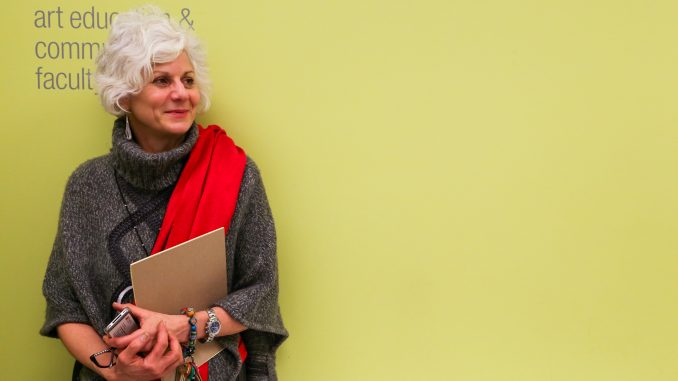
While driving home through an ice storm from a trip to Chicago, Dr. Lisa Kay paid particular attention to the way the ice clung to the dead trees, an image she remembered a student had shared while brainstorming ideas for her art project.
When Kay returned to class the next week, she told the student she had thought of her, much to the student’s surprise.
“[The student] said, ‘Ms. Lisa, I can’t believe it – you were really thinking of me?’ and it’s like, ‘Well yeah, I just thought about what you said and it struck a chord with me,’” Kay said.
Through an art education program, Kay has been working with young women, ages 15-18, from the Carson Valley Children’s Aid School for more than a year.
“This is an art education class,” Kay said. “We’re not necessarily focusing on therapeutic change or therapeutic growth, but [the girls] are in sort of a therapeutic day treatment program – they’re in residential care. So, that’s kind of a side benefit, that they felt like they’re not alone, like some people may have some of the same problems.”
The program was inspired in part by the work of Friedl Dicker-Brandeis with children living in the Terezin ghetto camp during the Holocaust.
“Teaching art in a setting like that, [where] people can have a sense of hope with an environment that is filled with despair – art has a lot of power,” Kay said.
Kay studied more than 4,000 pieces of art made under Dicker-Brandeis’ instruction. The art was designed to help the children she worked with find beauty in traumatic surroundings.
The girls at Carson have been through extremely difficult and traumatic events themselves, Kay said. Some were sent to the school on court order, while others have spent their lives in the foster care system.
“Some of these young ladies, when you hear some of their stories, some of the trauma they’ve experienced in the first 15 years of their life is a lifetime of experiences and stress that nobody wants to have to go through,” Kay said.
It was important to Kay to gear the program toward positivity and the special experiences they have had, she said. Two of the themes of the projects the group worked on, “beauty and ugly” and “lost and found,” were designed to bring forward those messages of hope.
For the “lost and found” project, the girls had to use eight to 10 found items to be incorporated into a mandala – a circular balanced design. The design conveys ideas of wholeness to help the girls recognize that even though they have experienced loss, they are still “whole,” Kay said.
The art projects have helped many of the girls express themselves in a way they otherwise may have not been able to. In addition to paintings, drawings and other mediums, Kay has also guided to the girls through writing poetry and keeping a journal.
Some of the projects the girls have worked on are now on display as part of “FireFly Illuminations,” an exhibit at the Woodmere Art Museum, located in Chestnut Hill, which opened on Jan. 18.
The exhibit, which will have its grand opening ceremony on Feb. 12, is also an opportunity for the girls to curate their own work.
All of the art featured in the exhibit is accompanied by an artist book in which the girls say what they like about their work and what they would change, as well as an explanation behind the piece.
“It’s not as typical to see work on display from students who have experienced trauma or from students who are in residential care,” Kay said. “These kids are more marginalized, they’re just not as typical of regular art classrooms. So to have a show of their work is special and unique for them.”
Kay said she hopes to continue to partner with the Woodmere in future programs with Carson and plans to publish the work as a curriculum that can potentially be utilized by art educators in the future.
On Feb. 14, Kay will be hosting a “gallery tour and tea” for art educators from across the state to discuss the project, present the finished curriculum and listen to their input for how the program could be used in other settings.
“Art teachers aren’t always prepared to deal with trauma,” she said. “We need to sort of understand, how can a teacher in a regular classroom, and specifically an art classroom, be supportive without doing therapy? I see no reason why educators should not be more trauma-informed.”
Though she has worked with people of all ages, Kay said she enjoys working with young women in particular because of the difficulties they face.
“In our world today, there are lots of challenges for young women, especially women who live in poverty, who have experienced a lot of sexual abuse, physical abuse, drug abuse – either their own or from people around them,” Kay said.
“We have such a violent culture,” she added. “I just feel like anything that can be done to bolster young women’s self-esteem and sense of strength is an important place to spend my time and energy.”
Alexa Bricker can be reached at abricke1@temple.edu


Be the first to comment